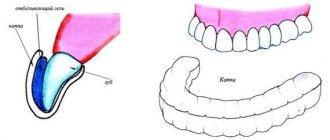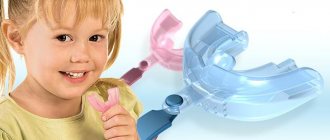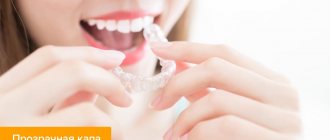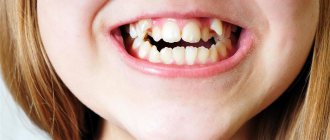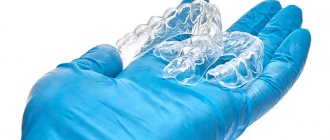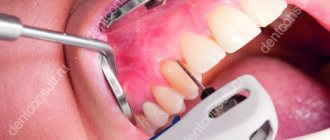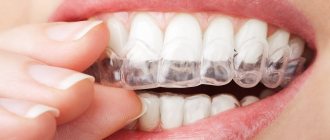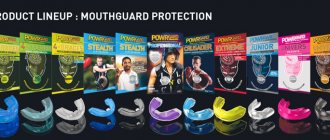Content:
- What are teeth whitening trays?
- Treatment Options
- Indications for aesthetic procedures
- Features of the technique
- What does the brightening gel contain?
- Other features of the technique
- Who is contraindicated for home lightening?
- Pros and cons of the technique
You can make your smile beautiful at home using special whitening trays.
But before starting aesthetic activities, you must definitely visit a doctor. The specialist will examine the condition of the enamel, determine whether there are any contraindications to such therapy, and give useful recommendations. Without obtaining dental advice, you should not use whitening trays, as there is a risk of complications.
When it is contraindicated
An important issue when whitening teeth using trays concerns possible contraindications. They boil down to the following:
- you should avoid such cleansing while taking potent drugs;
- if there are serious systemic diseases;
- pregnancy and breastfeeding;
- excessive smoking;
- presence of severely damaged teeth;
- possible allergy to gel components or mouthguard material;
- if you have diseases of the temporomandibular joint;
- molar hyperesthesia.
What are teeth whitening trays?
Plates do not lighten teeth on their own. They serve as a place for laying the whitening material and ensure its long-term contact with the enamel. For the devices to work, a solution based on hydrogen peroxide or urea is placed in them.
The first remedy is considered the most powerful. It removes yellowness faster and allows you to get the desired result in a short time. But it works more aggressively than carbamide peroxide, so it is not recommended to use it if the units are highly sensitive.
What whitening systems exist?
Today, dentists most often use the following whitening tray systems:
- Discus Dental Nite White and Day White ACP . The main component used in the system is amorphous calcium phosphate, a special tooth enamel restorer, as well as potassium nitrate and fluorine, which reduce the sensitivity of molars. Available in different concentrations of hydrogen peroxide.
- Discus Dental Nite White Turbo . Contains an enhanced formula of six percent hydrogen peroxide, a pleasant mint aroma. Can be used throughout the night or several hours a day.
- Discus Dental Zoom! Weekender Kit . Contains an enhanced formula of six percent hydrogen peroxide, as well as an agent that enhances the effect of the gel over time. Can be used throughout the night or several hours a day.
- Opalescence by Ultradent . The composition contains viscous carbamide peroxide and also contains a mixture of potassium nitrate and fluorine. Available in three variants - mint and melon formula, as well as unscented. After just ten days of use, you can notice obvious results.
- Opalescence Trèswhite Supreme . Ideal for travel, or before an important business meeting. An innovative system, one size fits all. The aligners have a two-layer system, which allows them to be aligned automatically. Contains an enhanced formula of ten percent hydrogen peroxide, as well as a mixture of potassium nitrate and fluoride.
Treatment Options
Teeth whitening with trays can be carried out according to different programs:
- Standard (basic). Has the most affordable price. A person buys a universal device at a pharmacy and uses it according to the instructions. This therapy is the most risky. It is not suitable for all patients and often causes allergies. Because the plate does not fit perfectly into the rows, the bleach solution may leak out of the plate. Then irritation of the mucous membranes of the oral cavity occurs, and small ulcers appear.
- Thermoplastic. Involves the use of elements that, after heating, change their shape and size. You just need to dip the product in hot water and put it on immediately. It will “suck” tightly, and after cooling it will retain its new shape. Thermoplastic products are much safer than standard ones. When used correctly, the likelihood of irritation of the mucous membranes is minimized.
- Individual. An option that is suitable for patients who want to get the perfect result. Is the most expensive. Mouthguards are made based on a cast of the jaws. Due to this, they perfectly fit each unit, securely hold the lightening gel inside, and do not irritate the mucous membranes. It is very convenient to use individual products. True, their cost is not low.
Types of individual mouthguards for teeth
- Standard mouthguards.
They are mass produced using one template, so they are not able to take into account the individual characteristics of each patient’s dentition. The material used is polyvinyl chloride (currently banned in EU countries), rubber or plastic. Their advantages are low price and the possibility of immediate use. The design has many more disadvantages. It may have an unpleasant chemical taste and odor, and may not adhere tightly to the teeth. In addition, many patients report severe discomfort when wearing.
- Thermoplastic mouthguards.
Made from silicone with special additives, which becomes very soft when exposed to hot water. In this form, the mouth guard is put on the teeth and the material is allowed to cool. As a result, it takes the desired shape, quite accurately repeating the features of the dentition. But still, a thermoplastic mouthguard does not always fit perfectly to the teeth. Most often, it is used as a retainer to consolidate treatment results achieved with another orthodontic design.
- Individual mouthguards.
The best option for correcting the bite and straightening the dentition. These mouth guards are made from individual impressions using 3D modeling. Thanks to the thermoplastic material and the vacuum technologies used, this design most accurately replicates the features of the dentition.
Features of the technique
The patient is offered products made from hypoallergenic and biocompatible materials, so wearing them does not harm his health. Most often, plates are made from:
- plastic;
- silicone;
- gel-like composite.
Under no circumstances should they be worn on a regular basis. Whitening should be carried out in short courses. Otherwise, the enamel will be damaged. Deep cracks will appear on its surface. Pathogenic microorganisms will begin to multiply in them, which will lead to caries and pulpitis.
What does the brightening gel contain?
Standard and thermoplastic fixtures are sold together with a universal gel. Its active substances are hydrogen peroxide or carbamide. The composition may also contain compounds that strengthen the upper layers of the dental crown, for example, calcium, fluorine, sodium.
In the case of individual products, the selection of whitening gel is carried out on a personal basis. The dentist takes into account:
- patient's age;
- mouth condition;
- desired result;
- tendency to specific dental diseases;
- presence of allergies to medications.
At his discretion, he may offer material with a higher or, conversely, lower content of the bleaching component. This will allow you to get the smile of your dreams quickly and without risks to your oral health.
Enamel whitening procedure using trays
The procedure for whitening tooth enamel using trays includes:
- carrying out hygienic measures related to oral care;
- filling the tray with a whitening gel containing carbamide peroxide;
- fixing the mouth guard on the teeth;
- removing excess gel with a napkin or toothbrush;
- mouth rinse;
- removing the mouth guard;
- Repeated rinsing of the mouth with water.
The duration of the course of whitening procedures can vary from 7 to 21 days. During the treatment period, the patient is prohibited from smoking and eating citrus fruits, red wine, juices, apples, tea, beets, blueberries, coffee and other coloring products.
Other features of the technique
Thanks to the mouth guard, the gel material is distributed as evenly as possible over the teeth. Not a single part of it remains uncultivated. This guarantees a brilliant aesthetic result. Among other features of this whitening:
- Lasts about two to three weeks. Improvement in the appearance of teeth becomes noticeable after three to four procedures. Therefore, do not despair if after the first use of the solution nothing has changed.
- It can be carried out only if the condition of the oral cavity is satisfactory. If during the initial appointment the dentist discovers any diseases, they must be cured. It is unacceptable to apply a composition with carbamide or hydrogen peroxide to carious cavities or inflamed gums.
- You cannot start therapy without first carrying out professional hygiene. The latter is needed to clean the crowns from stone and plaque. If you do not go through it, the units will lighten unevenly, which will look strange and unsightly.
- Helps increase sensitivity. This is normal, since the enamel is exposed to quite serious damage every day. But, if the toothache becomes severe, you should stop aesthetic procedures and seek medical help again.
- You need to wear the devices for as long as the doctor says - and not a minute longer. Some people deliberately increase the duration of their sessions in an attempt to get faster results. This is unacceptable, since the whitening gel can destroy the enamel.
- Affordable price. Home whitening usually costs less than in-office whitening. We cannot ignore the fact that it takes place in comfortable and familiar conditions for a person. During the sessions, he can do any work or relax quietly.
But not everyone can use whitening trays, despite their advantages. This dental technique has certain limitations.
Orthodontic dental guards
These aligners are used to correct malocclusions. At the moment, there are several types of orthodontic aligners on the market from different manufacturers, including Star Smile aligners, the well-known aligners.
But not all orthodontic aligners are capable of solving serious bite problems; they only help to close the spaces between the teeth and correct minor curvatures.
Much has changed when Russian-made orthodontic mouthguards or aligners from the Star Smile company appeared; they became serious competitors to braces, since they can correct almost all defects in the development of bite.
Who is contraindicated for home lightening?
The method cannot be used:
- in working with children under the age of eighteen, pregnant and breastfeeding women, people who had an extraction less than four weeks ago;
- if you have a piercing in your mouth;
- for untreated diseases of teeth and gums;
- when serving poorly disciplined patients who ignore medical prescriptions.
It is also prohibited to perform whitening if the patient is allergic to the dental material that needs to be used.
Dental mouth guard
Unlike a sports mouthguard, which is used only for impact protection, a dental mouthguard has a wider range of applications. A dental mouth guard is made from special plastic materials – silicone or polyurethane.
The convenience of the mouth guard is that it can be used to solve many problems - from therapeutic to orthodontic treatment. And at the same time, the mouthguards are convenient to use - the patient can take them off and put them on himself, according to the schedule established by the attending physician.
Pros and cons of the technique
To make it easier to understand whether this dental program is right for you, we will list its main advantages and disadvantages. The first include:
- availability;
- the ability to independently carry out all procedures;
- high efficiency;
- bleaching occurs immediately from the outside and inside;
- possibility of personal selection of gel and production of individual plates.
Among the disadvantages:
- You will still have to visit the dentist’s office;
- while wearing a mouth guard, you cannot talk, eat, or drink;
- incorrect application of the gel and wearing the plates for too long cause irritation of the gums and mucous membranes;
- long term events.
In any case, you can only answer the question “to be or not to be” together with your dentist. Therefore, be sure to visit your doctor before purchasing the kit from the pharmacy.
How to care for your mouthguards
Typically, mouthguards do not require special care. Modern dental mouth guards often just need to be rinsed with running water. Less often they need to be cleaned with toothpaste and a brush. When using orthodontic aligners, the doctor will definitely advise you on how to care for them.
Sports mouthguards require slightly different care and are stored in separate containers and periodically placed in a special solution to extend their life. Any sports mouthguard comes with its own instructions for use and care.
Application trays have their own service life and, as a rule, are not designed for long-term use.
It is enough to wash decorative mouth guards after use under running water, or, in extreme cases, with soap or brush them with a toothbrush.
